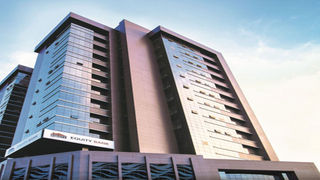
Equity Bank has been chipping away on the market share of the top five banks, Stanbic, Centenary, Standard Charted Bank, Bank of Baroda and dfcu. PHOTO/EDGAR R. BATTE
|Markets
Prime
What is fueling the “fastest growing bank”?
What you need to know:
- Since 2016, Equity has been the fastest growing bank in Uganda. Its growth has been above the industry average. This growth has propelled Equity from 15th place to now the 6th largest bank with assets of Shs2.8 trillion.
- Market share. Equity Bank’s market-share of deposits since 2011 to 2021 has grown from 1.75 percent to 8 percent, the fastest growth in market-share over the period.
In 2007, Bank of Uganda (BoU) announced the lifting of a moratorium on licensing new banks. The moratorium had been in place since 2004.
In July 2008, Kenya’s Equity Group acquired 100 percent stake at $26 million in Uganda Microfinance Limited (UML) with the aim of eventually securing a full commercial banking licence. UML had a wide footprint, operating nearly 30 branches across the country, which provided a good entry point for Equity Bank.
Armed with this acquisition, the ambition was turn Equity into one of the most significant players in Uganda’s banking sector. That did not start out as well as planned. Equity faltered at the start and ended up closing some of the UML branches due to their location (in rural areas) that could not generate enough money to be self-sustaining. In 2009, a year after opening its doors in Uganda, Equity made losses of Shs6.3 billion. In 2010, losses expanded to Shs22 billion. In 2011, the situation started turning around, with Equity making its first profit in Uganda but it was still not growing fast enough.
In 2011, Equity had an asset base of Shs205 billion and was ranked 15th out 25 commercial banks in Uganda.

Equity Group managing director James Mwangi. PHOTO/FILE
The Equity Group in 2014 decided to tilt the tables and started the ambitious drive to grow the Equity network, after clearing the accumulated losses from acquisition of UML. Since 2016, Equity has been the fastest growing bank in Uganda. Its growth has been above the industry average. This growth has propelled Equity from 15th place to now the 6th largest bank with assets of Shs2.8 trillion. For the executives within Equity Bank, they have not reached their peak. From the banks that started operations after the 2007 moratorium was lifted, Equity is only one to have grown passed the number ten bank.
Equity has been aggressive in growing the number of customers, focusing on retail and traders. It has been chipping away on the market share of the top five banks, Stanbic, Centenary, Standard Charted Bank, Bank of Baroda and Dfcu but also growing faster than banks below it. Its market-share of deposits since 2011 to 2021 has grown from 1.75 percent to 8 percent, the fastest growth in market-share over the period. The aggressive pursuit of deposits has enabled the bank also grow its lending business, the cash-cow. In 2011, Equity only controlled 1.3 percent of total loans but by the end of 2021, this had grown to 9 percent of total loans. In terms of lending, Equity is the fourth largest lender ahead of Standard Chartered Bank and dfcu.
Much of Equity’s growth strategy is driven by a broader Equity Group expansion drive to become the largest bank in East Africa. In 2017, BoU allowed Agent Banking and Equity used its experience in Kenya to become the fastest bank to incorporate this strategy with its famous “EquiDuuka”. From its aggressive pursuit, Equity has its eyes on being the top bank in Uganda but has to deal with Stanbic and Centenary that still have a significant market-share compared to the rest of the banking sector.
Honourable mentions

Stanbic bank headquarters in Kampala. Stanbic bank is Uganda’s largest bank by assets and customer deposits. PHOTO/edgar R. Batte
Uganda’s largest bank by assets, deposits, and customer deposits is Stanbic Bank. It controls an asset market-share of about 21 percent. The closest market-share for Stanbic is Centenary Bank that has about 11 percent market-share in terms of assets. Centenary Bank had a market-share of 7 percent in 2012 but it has since grown that share into double digits. In 2012, Standard Chartered Bank, Absa (previously Barclays) and Crane Bank were ahead of it.
Largest footprint
As end of 2021, Centenary had overtaken these three, including dfcu which acquired some of the assets of Crane Bank in 2017. Much its growth has been fueled by improved retail and corporate banking.
Importantly, Centenary has used its large footprint across the country to provide loans to groups and collect on deposits. It has remained consistent within its operations whereas the banks it overtook have had significant internal changes that have, in part, disrupted their own operations.
In 1991, Uganda started on a privatisation drive that several state institutions sold to the private sector. Some of those included banks like Uganda Commercial Bank (UCB) that was sold to Standard Bank Group and became Stanbic Bank.
However, some of the state institutions were never privatised and they include Housing Finance Bank Uganda. Housing Finance Bank has gone through a series of phases but was performing just fine and keeping afloat. Even though Housing Finance Bank has not significantly moved in-terms of positioning, the market-share has been improving.
In the last five years, the Housing Finance Bank market-share has improved from 2.5 percent of total assets to 3.1 percent by the end of 2021. The bank controls about 60 percent of mortgage market in Uganda but has also made positive steps towards being efficient at commercial banking.




